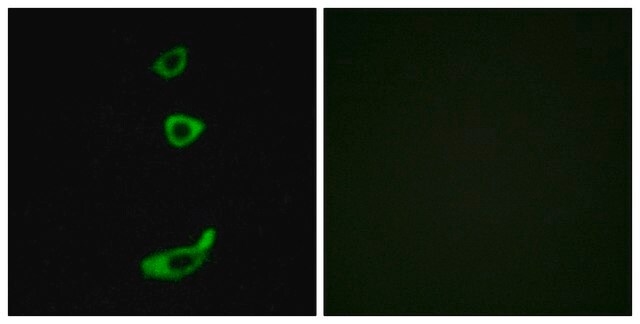Opis ogólny
Dokładamy wszelkich starań, aby dostarczać bardziej ekologiczne produkty alternatywne, które są zgodne z co najmniej jedną z 12 zasad zielonej chemii. To przeciwciało nie zawiera konserwantów, zostało wyprodukowane bez szkody dla zwierząt i jest wyjątkowo stabilne, aby umożliwić wysyłkę i przechowywanie w razie potrzeby, a tym samym jest zgodne z "Zapobieganiem powstawaniu odpadów", "Projektowaniem bezpieczniejszych chemikaliów" i "Projektowaniem pod kątem efektywności energetycznej".
Kliknij tutaj, aby uzyskać więcej informacji.
Przeciwciała 10889 stanowią całkowicie nową generację rekombinowanych przeciwciał monoklonalnych. Każde przeciwciało 10889 jest wytwarzane przy użyciu naszego zastrzeżonego systemu ekspresji rekombinowanej, oczyszczane do jednorodności i precyzyjnie dozowane w celu uzyskania solidnej i wysoce powtarzalnej konsystencji między partiami. Do użytku badaczy udostępniane są wyłącznie klony o najwyższej wydajności. Każde przeciwciało jest walidowane pod kątem wysokiej swoistości i powinowactwa w wielu zastosowaniach, w tym w najczęściej używanym zastosowaniu. Przeciwciała 10889 są niezawodnie dostępne i gotowe do wysyłki, gdy są potrzebne.
Specyficzność
Klon 1N21 to rekombinowane królicze przeciwciało monoklonalne 10889, które specyficznie wykrywa receptor czynnika uwalniającego kortykotropinę 1 (CRFR1). Celuje w epitop w obrębie 15 aminokwasów od pierwszej domeny zewnątrzkomórkowej w N-końcowej połowie.
Immunogen
Liniowy peptyd sprzężony z KLH odpowiadający 15 aminokwasom z pierwszej domeny zewnątrzkomórkowej w N-końcowej połowie ludzkiego receptora czynnika uwalniającego kortykotropinę 1 (CRFR1).
Zastosowanie
Testy kontroli jakości
Oceniane metodą Western Blotting w lizacie komórek PC12.
Analiza Western Blotting: Rozcieńczenie 1:10 000 tego przeciwciała wykryło CRFR1/CRHR1 w lizacie komórek PC12.
Testowane aplikacje
Analiza Western Blotting: Rozcieńczenie 1:1000 z reprezentatywnej partii wykryło CRFR1/CRHR1 w lizatach ludzkiego mózgu i ludzkiej przysadki mózgowej.
Analiza immunocytochemiczna: Rozcieńczenie 1:100 z reprezentatywnej partii wykryło CRFR1/CRHR1 w komórkach Neuro2A.
Affinity Binding Assay: Reprezentatywna partia tego przeciwciała związała peptyd CRFR1/CRHR1 z KD wynoszącym 2,9 x 10-6 w teście wiązania powinowactwa.
Uwaga: Rzeczywiste optymalne rozcieńczenia robocze muszą być określone przez użytkownika końcowego jako próbki, a warunki eksperymentalne mogą się różnić w zależności od użytkownika końcowego.
Opis wartości docelowych
Receptor czynnika uwalniającego kortykotropinę 1 (UniProt: P34998; znany również jako CRF-R-1, CRF-R1, CRFR-1, Corticotropin-releasing hormone receptor 1, CRH-R-1, CRH-R1) jest kodowany przez gen CRHR1 (znany również jako CRFR, CRFR1, CRHR) (Gene ID: 1394) u człowieka. CRFR1, członek rodziny receptorów sprzężonych z białkiem G 2, jest wieloprzebiegową, heterodimeryczną glikoproteiną błonową, która jest syntetyzowana z peptydem sygnałowym (aa 1-23), który jest następnie odcinany w celu wytworzenia dojrzałego białka zawierającego siedem domen transbłonowych. Ulega ekspresji głównie w móżdżku, przysadce mózgowej, korze mózgowej i płatach węchowych. Może heterodimeryzować z receptorem estrogenowym 1 sprzężonym z białkiem G (GPER1). CRFR1 wiąże neuropeptydy z rodziny hormonów uwalniających kortykotropinę, które są głównymi regulatorami szlaku podwzgórze-przysadka-nadnercza i odgrywają ważną rolę w organizowaniu neuroendokrynnych, behawioralnych i autonomicznych odpowiedzi na stres. Wykazuje wysokie powinowactwo do czynnika uwalniającego kortykotropinę (CRH) i urokortyny (UCN). Wykazano, że wiązanie ligandu powoduje zmianę konformacji, która wyzwala sygnalizację za pośrednictwem białek G i efektorów niższego rzędu, takich jak cyklaza adenylanowa. CRFR1 jest również wymagany do prawidłowego rozwoju embrionalnego nadnerczy i normalnej odpowiedzi hormonalnej na stres. Wykazano, że fosforylacja seryny 301, która znajduje się w trzeciej pętli wewnątrzkomórkowej, ma kluczowe znaczenie dla jej skutecznego sprzęgania z białkami G i generowania drugich przekaźników. Jego fosforylacja przy serynie 330 przez kinazę białkową A (PKA) zapobiega maksymalnemu sprzężeniu z białkiem Gq, a tym samym negatywnie reguluje jego sygnalizację. Opisano pięć izoform CRH-R1, które są wytwarzane przez alternatywny splicing. To rekombinowane przeciwciało monoklonalne 10889, generowane przez naszą zastrzeżoną technologię, oferuje znacznie zwiększoną swoistość, powinowactwo, powtarzalność i stabilność w porównaniu z konwencjonalnymi monoklonalnymi przeciwciałami. (Ref.: Bender, J., et al. (2015). PLoS ONE 10(9): e0136768; Pioszak, AA., et al. (2008). J. Biol. Chem. 283(47); 32900-32912; Papadopoulou, N., et al. (2004). Mol. Endocrinol. 18(3); 624-639).
Postać fizyczna
Oczyszczone rekombinowane królicze przeciwciało monoklonalne IgG, liofilizowane w PBS z 5% trehalozą, o normalnym wyglądzie gruboziarnistej lub półprzezroczystej żywicy. Składniki PBS/trehaloza w preparacie ZooMAb mogą mieć wygląd półstały (żel przypominający kulki) po liofilizacji. Jest to zjawisko normalne. Należy postępować zgodnie z zalecaną procedurą rekonstytucji zawartą w arkuszu danych, aby rozpuścić półstały, przypominający kulki materiał o wyglądzie żelu. Otrzymany roztwór przeciwciała jest całkowicie stabilny i funkcjonalny, co potwierdzają pełne testy funkcjonalne. Nie zawiera biocydów ani konserwantów, takich jak azydek, ani żadnych produktów ubocznych pochodzenia zwierzęcego. Większe opakowania są dostarczane jako wielokrotności 25 µL.
Przechowywanie i stabilność
Zaleca się przechowywanie liofilizowanego produktu w temperaturze 2-8°C. Przed rekonstytucją fiolki należy krótko mikrowirować, aby odwirować materiał na dno fiolki. Każdą fiolkę należy odtworzyć, dodając 25 µl przefiltrowanej wody laboratoryjnej lub PBS. Odtworzone przeciwciała można przechowywać w temperaturze 2-8°C lub -20°C w celu długotrwałego przechowywania. Unikać wielokrotnego zamrażania.
Informacje prawne
ZooMAb is a registered trademark of Merck KGaA, Darmstadt, Germany
Oświadczenie o zrzeczeniu się odpowiedzialności
O ile nie określono inaczej w naszym katalogu lub innej dokumentacji firmy dołączonej do produktu(-ów), nasze produkty są przeznaczone wyłącznie do użytku badawczego i nie mogą być wykorzystywane do żadnych innych celów, w tym między innymi do nieautoryzowanych zastosowań komercyjnych, zastosowań diagnostycznych in vitro, zastosowań terapeutycznych ex vivo lub in vivo lub jakiegokolwiek rodzaju konsumpcji lub zastosowania u ludzi lub zwierząt.
Ta strona może zawierać tekst przetłumaczony maszynowo.






